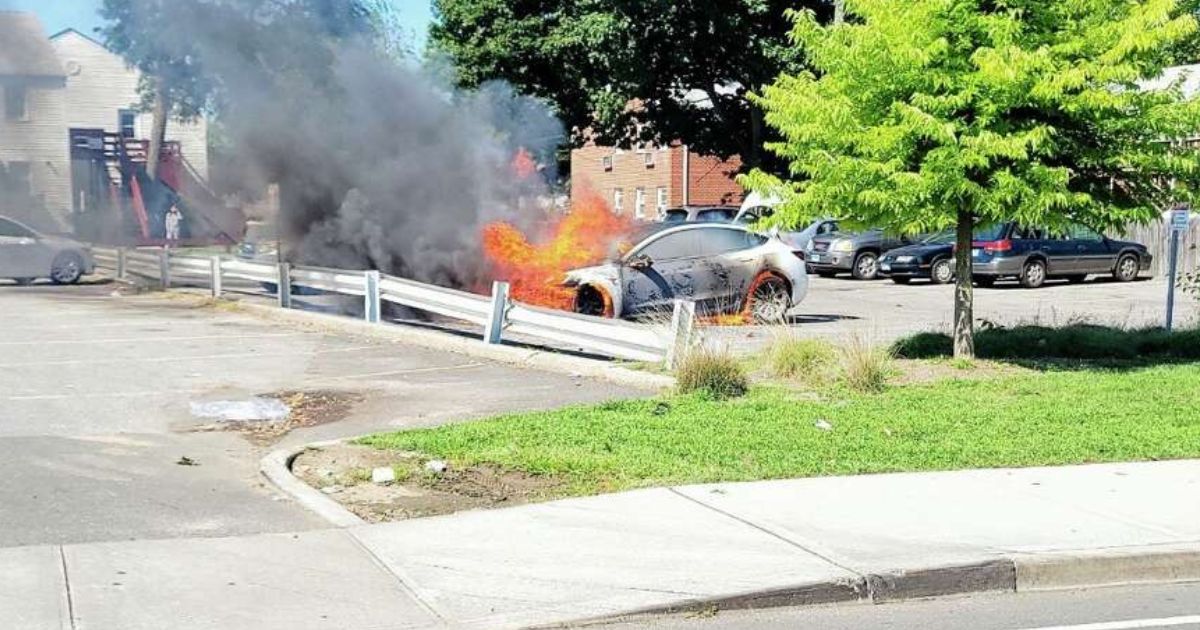It’s no secret that some electric cars have been susceptible to their lithium batteries catching fire.
What’s increasingly becoming known to fire departments is how difficult those blazes are to put out. A Stamford, Connecticut, fire involving a Tesla took three times the normal effort to extinguish, according to the Stamford Fire Department.
And this fire was perhaps an easy one — the car’s batteries fell out of the vehicle onto the ground where firefighters had better access.
The fire occurred Thursday morning behind a Main Street restaurant, according to the fire department’s website.
It took 600 gallons of water a minute to put out the Tesla fire in Stamford. https://t.co/fdlBG1enxv #TSLA pic.twitter.com/GBioPWghUa
— TeslaNews (@Teslanews10) September 17, 2022
A responding fire department normally uses a single hose line, according to the department commander on the scene, Deputy Chief Eric Lorenz.
But firefighters knew electric car fires require more effort, so two more hoses were aimed at the car. “We know from other fire departments’ experiences that large amounts of water are the only solution when compared to a traditional vehicle fire,” Lorenz said.
Large amounts of water, indeed — 600 gallons per minute — and the fire took 42 minutes to put out, WTIC-TV reported.
Other vehicles in the area were far enough away from the burning Tesla to avoid damage, fire officials said.
More than five hours after the initial report of the fire, the Connecticut Department of Energy and Environmental Protection, the Stamford Fire Hazmat Team and a company specializing in hazardous waste were on the scene, readying the Tesla for removal, according to the fire department.
“This is no routine car fire,” Lorenz said. “It requires special handling.”
Similar risks exist in electric vehicles as outlined in a 2016 Tesla Model S guide to first responders.
The guide also said 3,000 to 8,000 gallons of water would be required to extinguish a car fire, but Captain Parker Wilbourn of the Sacramento Metropolitan Fire District told The Washington Post the required water usage could reach 30,000 gallons.
In the Connecticut fire, if the fire department pumped 600 gallons a minute for the entire 42 minutes, it would total more than 25,000 gallons.
A lithium battery fire continues until all energy is spent. “We’re basically fighting energy release,” Wilbourn said.
Wilbourn’s fire department faced a unique situation when a Tesla caught fire in a scrapyard near Sacramento.
The car had been placed in the wrecking yard three weeks earlier after a crash, and a spontaneous battery fire required thousands of gallons of water to be pumped into a tractor-excavated pit that firefighters dug for placement of the vehicle.
Each time firefighters got the fire out, it reignited, despite having the car on its side for easy access to the batteries.
It took an hour and 4,500 gallons of water to extinguish the fire; that amount of water is typically used in a building fire, the Post reported.
Wilbourn said the Sacramento fire department anticipates more fires as increased numbers of EV chargers are placed in garages.
In the mad rush to electrify road vehicles to offset perceived risks of carbon emissions, the greenies refuse to face the realities of balancing costs and benefits.
Environmental and social costs of securing electric car components are becoming more widely known along with limitations of EV range and problems with charging.
Now come the challenges of extinguishing EV fires along with hazardous materials in cleanups.
Worse, states like California are outlawing new internal combustion vehicle sales within a relatively short amount of time. Are we ready to abandon an established manufacturing, fuel, parts and maintenance system for what might be an unworkable green folly?
Whatever benefits there might be for use of electric vehicles in, perhaps, some circumstances, all efforts to move in this direction must be balanced with the realities of unintended consequences of an ideologically-driven, poorly thought out effort.
This article appeared originally on The Western Journal.

























 Continue with Google
Continue with Google